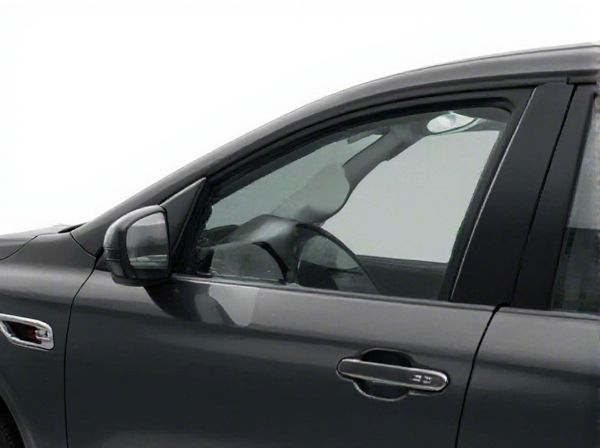
Photo illustration: Extended Arm Mirror vs Standard Arm Mirror
Extended arm mirrors provide a wider field of view by projecting beyond the vehicle's body, enhancing safety during lane changes and parking. Standard arm mirrors offer a more compact design that maintains aerodynamics but may limit visibility compared to extended versions. You can improve driving confidence by choosing extended arm mirrors for better blind spot coverage.
Table of Comparison
| Feature | Extended Arm Mirror | Standard Arm Mirror |
|---|---|---|
| Arm Length | Longer, extends further from vehicle | Shorter, standard factory length |
| Visibility | Improved side and rear view, ideal for towing | Basic visibility, suitable for everyday driving |
| Installation | Requires additional mounting hardware | Direct factory fit, easy installation |
| Adjustability | Often features extendable and telescoping arms | Fixed arm length with standard adjustability |
| Use Case | Recommended for trailers, large loads, and trucks | Ideal for regular passenger vehicles |
| Durability | Typically heavy-duty, built for rugged use | Standard durability for everyday conditions |
Introduction to Arm Mirrors
Arm mirrors enhance vehicle safety by improving the driver's field of vision, with extended arm mirrors providing a wider, more adjustable view compared to standard arm mirrors. Standard arm mirrors typically offer basic visibility suitable for everyday driving, while extended arm mirrors are designed for larger vehicles or towing applications, allowing better monitoring of adjacent lanes and trailers. The choice between extended and standard arm mirrors depends on the specific needs for spatial awareness and maneuverability during driving.
What Is an Extended Arm Mirror?
An extended arm mirror is a vehicle side mirror mounted on a telescoping or foldable arm, designed to provide a wider field of view compared to standard arm mirrors. This type of mirror is commonly used on trucks, trailers, and towing vehicles to improve visibility around large loads or camper attachments. Extended arm mirrors enhance safety by reducing blind spots and allowing drivers to see further behind and alongside their vehicle.
What Is a Standard Arm Mirror?
A standard arm mirror features a fixed, short mounting arm that places the mirror close to the vehicle body, offering a compact design ideal for regular driving conditions. This type of mirror provides a stable field of view suitable for passenger cars and smaller vehicles where extended visibility is not critical. Its shorter arm limits protrusion, reducing vibrations and potential damage from close encounters while driving in urban environments.
Key Differences Between Extended and Standard Arm Mirrors
Extended arm mirrors offer increased visibility by protruding further from the vehicle, making them essential for towing and larger vehicles. Standard arm mirrors provide a streamlined fit closer to the vehicle body, suitable for typical driving conditions with less obstruction. The extended design enhances safety by reducing blind spots during lane changes and reversing, while standard mirrors prioritize aerodynamics and aesthetics.
Pros and Cons of Extended Arm Mirrors
Extended arm mirrors provide enhanced visibility by extending farther from the vehicle, making them ideal for towing and wide loads. Their main advantages include better rear and side views, reducing blind spots and improving safety for large vehicles like trucks and RVs. However, extended arm mirrors can be more prone to damage in tight spaces and are generally more expensive than standard arm mirrors.
Pros and Cons of Standard Arm Mirrors
Standard arm mirrors offer a compact design that enhances vehicle aesthetics and reduces aerodynamic drag, improving fuel efficiency. However, their limited extension can restrict visibility when towing wide loads or maneuvering in tight spaces, increasing blind spots. Maintenance and replacement costs tend to be lower compared to extended arm mirrors, making them a cost-effective choice for everyday driving.
Use Cases: When to Choose an Extended Arm Mirror
Extended arm mirrors provide enhanced adjustability and wider viewing angles, making them ideal for vehicles requiring greater visibility, such as trucks, SUVs, and trailers. They excel in complex driving scenarios like towing, off-roading, and highway merging, where standard mirrors may have blind spots. Choosing an extended arm mirror improves safety and driving precision by offering optimal rearward visibility in demanding environments.
Use Cases: When to Choose a Standard Arm Mirror
Standard arm mirrors are ideal for everyday driving and urban environments where close proximity to traffic and obstacles requires a mirror that offers a broad field of view without excessive extension. They are best suited for passenger vehicles and smaller trucks, providing reliable visibility while maintaining aerodynamics and reducing the risk of damage in tight spaces. Choose a standard arm mirror when maneuverability and compactness are priorities, such as in city driving or on narrow roads.
Installation and Adjustment Considerations
Extended arm mirrors require secure mounting to support their longer reach, often necessitating reinforced brackets or additional hardware compared to standard arm mirrors. The installation process may involve drilling into sturdier surfaces to ensure stability and prevent mirror wobble during use. Adjustment of extended arm mirrors typically offers greater flexibility in positioning, allowing for enhanced visibility angles but requiring more precise alignment to avoid obstructing the driver's view.
Which Mirror Type Is Right for You?
Extended arm mirrors offer greater flexibility and reach, making them ideal for larger vehicles or those requiring wider viewing angles, while standard arm mirrors provide a more compact and streamlined design suited for smaller cars or everyday use. Consider vehicle size, towing needs, and driving habits when choosing between these mirror types to ensure optimal visibility and safety on the road. Selecting the appropriate mirror enhances confidence during lane changes, parking, and towing maneuvers.
 caratoz.com
caratoz.com